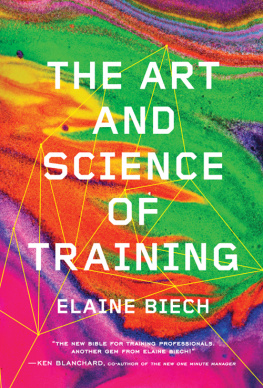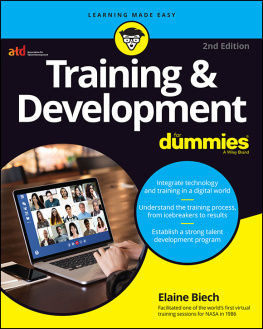Measuring for Success
What CEOs Really Think
about Learning Investments
2010 the American Society for Training and Development
All rights reserved. Printed in the United States of America.
No part of this publication may be reproduced, distributed, or transmitted in any form or by any means, including photocopying, recording, or other electronic
or mechanical methods, without the prior written permission of the publisher, except in the case of brief quotations embodied in critical reviews and certain other noncommercial uses permitted by copyright law. For permission requests, please go to www.copyright.com, or contact Copyright Clearance Center (CCC), 222 Rosewood Drive, Danvers, MA 01923 (telephone: 978.750.8400, fax: 978.646.8600).
ASTD Press is an internationally renowned source of insightful and practical information on workplace learning and performance topics, including training basics, evaluation and return on investment, instructional systems development, e-learning, leadership, and career development. Visit us at www.astd .org/astdpress.
Ordering information for print edition: Books published by ASTD Press can be purchased by visiting our website at store.astd.org or by calling 800.628.2783 or 703.683.8100.
Library of Congress Control Number: 2008937405 (for print edition)
Print edition ISBN: 978-1-56286-588-7
PDF e-book edition ISBN: 978-1-60728-356-0 2010-1
ASTD Press Editorial Staff:
Director: Dean Smith
Manager, ASTD Press: Jacqueline Edlund-Braun
Manager, Acquisitions and Author Relations: Mark Morrow
Senior Associate Editor: Tora Estep
Senior Associate Editor: Justin Brusino
Editorial Assistant: Georgina Del Priore
Copyeditor: Alfred Imhoff
Indexer: April Michelle Davis
Proofreader: Kris Patenaude
Interior Design and Production: Kathleen Schaner
Cover Design: Katherine Warminsky
Cover Illustration: Fry Design Ltd.
Contents |
| vii |
| xiii |
| 1 | 01 |
| 2 | 17 |
| 3 | 29 |
| 4 | 53 |
| 5 | 75 |
| 6 | 91 |
| 7 | 111 |
| 8 | 125 |
| 9 | 147 |
| 10 | 179 |
| 11 | 207 |
| 233 |
| Appendixes: |
| 235 |
| 247 |
| 251 |
| 253 |
| 265 |
| 269 |
| 273 |
| 275 |
| 283 |
| 285 |
| 286 |
T his unique book describes what senior executives of organizations need to understand about a successful learning and development function. By tapping into these executives perspectives, the book provides rare insight into what learning and development professionals must do to provide convincing evidence of success for formal learning programs.
Among all the stakeholders in learning and development programs, the most important group is top executivesnot only do they fund programs, but their commitment is necessary to sustain a viable learning process, and their support is thus essential to make programs successful. On the basis of interviews, surveys, research, and briefings with senior management teams, this book reveals what executives specifically want to see
and explores their disappointment with some of the data that has been delivered to date. It also explains how learning and development leaders can meet the needs of executives and interact with them to build a world-class learning and development function that delivers results.
Why Another Book on Training Evaluation?
An obvious question is whether there is a legitimate need for another book on training evaluation. With so many books on this subject, the market is saturated. So why do we need another one? There are two main reasons.
First, though previous books have described evaluation from the perspective of learning officers, learning professionals, and evaluators, the chief executives perspective has been limited to a few comments. This book, however, describes the perspectives of senior executives from a variety of organizations.
Second, learning and development professionals need the viewpoint from the top, because there is still confusion about which measures are most
significant for those making an organizations fiduciary decisionswhich matter for several important reasons:
- Top executives shape the nature, scope, and extent of learning and development in an organization. The learning and development function originates with senior executives. They provide initial funding in the early years and continue to fund the processexpecting an outcome they can understand and believe.
- Each year, top executives allocate funds to learning and developmentfunds that are also sought after by other groups. There is fierce competition for funds within an organization.
- Top executives commitment is necessary to provide the appropriate resources, facilities, people, and access to make learning and development a visible and necessary part of an organization.
- Top executives model the behavior desired in all other managers. Their actions and behavior translate directly into support for learning and development. This support is sorely needed to make the function successful. Essentially, the managers in an organization will watch the senior management team for those signals, cues, and specific actions that are related to the learning and development process.
- The involvement of top executives can add to the success of learning and development programs, enabling others to clearly understand an organizations mission, vision, and value. A key aspect of this is communicating the responsibility to apply and achieve success with learning and development.
Consequently, the power and influence of this senior executive group make it an absolute must for learning and development professionals to understand and deliver the measurement and evaluation data that this group wants. But this data has not always been delivered, and other books on training evaluation have failed to properly address this issue:
- By far, the vast majority of these books provide strategies, tactics, and techniques to make evaluation work. Basically, these are the tools and processes to evaluate learning and development. These are essential references. A few books focus on the need for different levels and types of evaluation. By design, these books do not necessarily reflect the views and needs of top executives.
- Some books attempt to reflect the viewpoint of the senior executives through the chief learning officer (CLO). The traditional approach when exploring what top executives want is to ask the CLObut this is not always the right way.
- A few books suggest that they contain the actual senior execu tive viewpointbut this is difficult to obtain. When surveys are provided to senior executives in an attempt to have them detail what they desire as measures of learning success, the data can be seriously flawed. For example, many CLOs have revealed that when the chief executive receives this type of request, he or she forwards it to the CLO for response. In essence, the CLO becomes a surrogate respondent to the survey questionnaire, raising doubts about the credibility of these types of surveys and studies.











